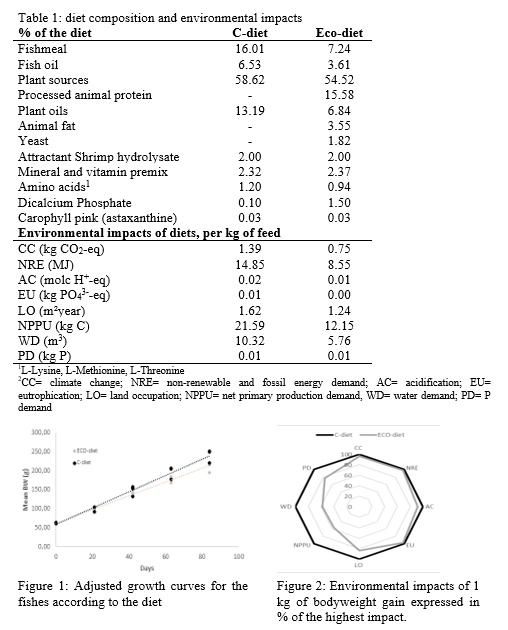ECO-FORMULATION OF FISH FEEDS: A PROMISING EFFICIENT SOLUTION TO LIMIT AQUACULTURE IMPACTS ON THE ENVIRONMENT
Introduction
To meet the growing demand for seafood and the need for protein sources, aquaculture is expanding. It now provides more than 50% of fish for human consumption and this proportion is expected to continue to increase over the long term to meet the food needs of more than nine billion people by 2050. All animal production systems, including aquaculture, are widely criticized for their environmental impact and animal feed is responsible for the majority of these. Currently, feeds are formulated to fulfill fish nutritional requirements while minimizing feed cost and taking into account incorporation constraints of particular feed ingredients such as fishmeal and fish oil. To reduce environmental footprint of feed, feed formulation should take simultaneously into account the cost and the environmental impacts of raw materials. Recently, Garcia-Launay et al. (2018) developed a multiobjective formulation algorithm which uses the constraints of least-cost formulation and calculates a multi-objective function that includes both feed cost and environmental impact indicators obtained by life cycle assessment (climate change, non-renewable energy use, phosphorus demand, land occupation). The objective of the present study was to adapt and apply this algorithm to design eco-friendly diet (eco-diet) and assess their nutritional value in rainbow trout.
Material & Methods
In this study, two isoprotein, isolipid and isoenergetic diets were formulated: a control diet (C-diet), close to commercial feeds currently used in rainbow trout aquaculture and an ECO-diet, formulated using a multiobjective function to minimize both the environmental footprint (including climate change, phosphorus demand, acidification, NPPU and water demand) and price of feed . The digestibility of the diet was measured and a 12 weeks-growth trial was conducted (3 tanks per diet) on juvenile rainbow to assess the consequences of these diets on growth performance, body composition and nutrient utilization. Finally, the results were used in a life cycle approach to estimate the environmental impact of 1 kg of body-weight gain.
Results
Diets are presented in Table 1. Multiobjective formulation reduced the level of fishmeal and fish oil of 55 % but introduced animal proteins and fat as well as yeast proteins (Table 1). Environmental impacts estimated by life cycle assessment were all subjected to a reduction from 23 to 46%. Whereas diets exhibited similar protein digestibility, the eco-diet showed a significant lower apparent digestibility coefficient (ADC) of lipids, energy and ash but enhanced ADC of starch, even ADC values could be all considered as high. At the end of the growth trial, no significant differences difference in body weight was observed but analysis of the growth curves using a mixed linear models revealed a significant difference between the two diets in favor of the control diet (Figure 1). Feed efficiencies were similar but daily feed intake was significantly enhanced in fish fed the C-diet. Fish fed the Eco-diet showed a lower protein gain resulting from higher protein intake. Body composition was similar between the two diets. Producing 1 kg of weight gain induces less environmental impacts with the Eco-diet than with the commercial diet, whatever the impact considered. The reduction is more important for NPPU, water demand and phosphorus demand (Figure 2).
Discussion
The present study demonstrates that lowering environmental footprint of the feed reduces the use of fishmeal and fish oil with little even no consequence of growth performance, but it can significantly reduce the environmental impact of producing one kg of trout, depending of the impact considered. Development of eco-friendly aquafeed through multi-objective formulation appears as a promising solution to reduce the reliance of aquaculture on marine ingredient and thus promote the sustainable development of aquaculture.
Keywords : multiobjective formulation, trout, digestibility, growth, LCA
